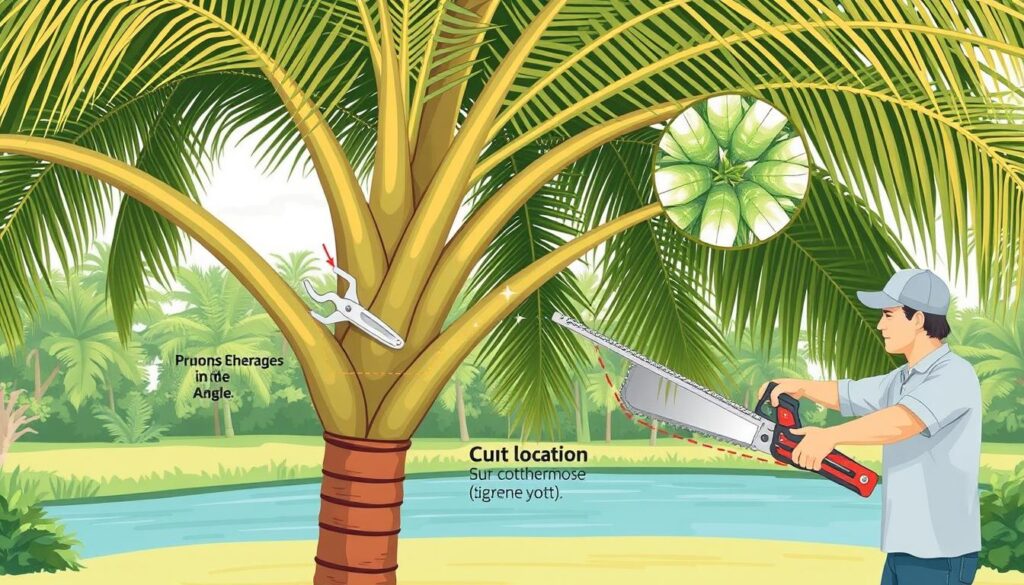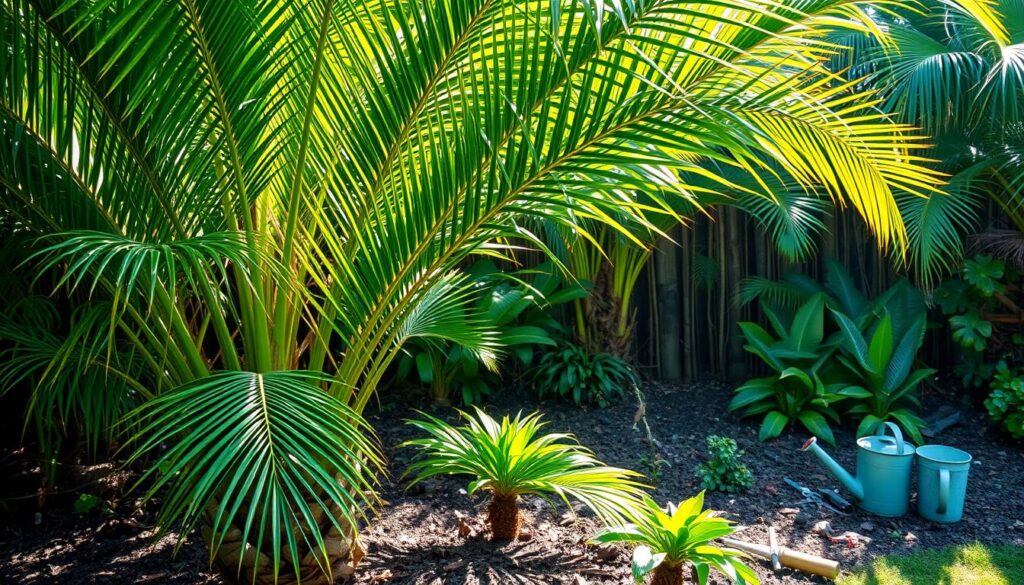Pruning a palm tree might seem hard, but it’s easy with the right tools and techniques. It’s key to understand why pruning is important. It keeps your palm tree healthy and looking good. For more on palm tree care, check out palm tree trimming guides.
Knowing when and how to trim a palm tree is important. The best time is in late winter or early spring. This helps the tree grow well. Dead or yellow fronds mean it’s time to trim. For a detailed guide on pruning, follow our steps.
Table of Contents
Key Takeaways
- Pruning palm trees is mainly for looks, as it doesn’t make new growth.
- The best time to trim palm trees is in late winter or early spring.
- Dead or yellow fronds show the tree needs nutrients and trimming.
- Pruning helps stop disease and keeps the tree looking healthy.
- Choosing the right tools for your palm’s size and type is key to avoid damage.
- Following a few tips and steps can help you trim palm trees well.
- Be careful when pruning to avoid harming the trunk or bud.
Understanding Palm Tree Pruning Basics
Pruning palms is key to their care. It removes dead fronds, stops disease spread, and boosts new growth. Knowing how to trim palm trees right is important to avoid harming the tree.
Timing and technique are critical in palm tree pruning. Too much pruning can stress the tree, while not enough can attract pests or diseases. Each palm tree type has its own pruning needs, so it’s vital to know these to prune well.
Why Regular Pruning is Important
Regular pruning keeps palm trees healthy and looking good. It removes dead fronds that can weigh the tree down and look bad. Pruning also stops disease spread and encourages new growth.
Different Types of Palm Trees and Their Pruning Needs
Various palm trees need different pruning. Some need more frequent pruning to keep their shape, while others need less to avoid damage. Knowing your palm tree’s specific needs is key to pruning it right.
When trimming palm trees, think about the type you have and its pruning needs. This approach ensures you prune without causing harm or promoting unhealthy growth. By using the right pruning techniques and understanding palm tree pruning basics, you can keep your palms healthy and vibrant.
Essential Safety Measures Before You Start
Before you start pruning your palm tree, it’s key to protect yourself and the tree. Wear gloves and safety glasses and use the right tools. Remember, safety comes first when trimming your palm tree.
A properly trimmed palm tree looks great and stays healthy. To do this, follow safety rules. If your tree is small, you can prune it right away. But for taller trees, it’s safer to hire an arborist.
Some important safety steps include:
- Wearing protective gloves and safety goggles
- Using a sturdy ladder or hiring an arborist for taller trees
- Disinfecting tools with a bleach and water solution to prevent disease spread
- Avoiding the use of spikes or cleats on climbing gear to prevent tree damage
By taking these safety steps, you can prune your palm tree safely and effectively. This ensures your tree stays healthy and looks great.
The Right Tools for Palm Tree Pruning
Pruning a palm tree needs the right tools. For smaller palms, use manual tools like pruning saws and hand pruners. These tools help make precise cuts and protect the tree.
For bigger palms, power tools like chainsaws work better. But, always wear protective gear to stay safe. Cutting back a palm plant with power tools is possible, but do it carefully and follow safety rules.
Some key tools for palm tree pruning include:
- Pruning saws
- Hand pruners
- Chainsaws
- Gloves
- Eye protection
Keep your tools clean and well-maintained to stop disease spread. With the right tools and safety steps, you can prune your palm tree well and get the results you want.
| Tool | Description |
|---|---|
| Pruning saw | Used for cutting thicker branches |
| Hand pruners | Used for cutting smaller branches and fronds |
| Chainsaw | Used for cutting larger branches and trunks |
How to Prune a Palm Tree: Step-by-Step Guide
To prune a palm tree, you need to know the process and the right techniques. Pruning is key to keeping your palm tree healthy and looking good. You prune to remove dead or damaged fronds, get rid of flowers and fruits, and improve views near roads. Remember, pruning healthy fronds doesn’t help the tree grow and can make it weaker by reducing food production.
The best time to prune palm trees is in the spring, before hurricane and fire seasons. When cutting fronds, make sure to cut at least 2 inches from the trunk. This prevents damage that could let pests in. Here are the steps to prune your palm tree:
- Remove dead, dying, or damaged fronds
- Eliminate flowers and fruits
- Improve visibility near roadways
- Reduce fire hazards from fronds too close to structures

Proper disposal of pruned materials is important. Local public works departments may have rules for disposing of palm waste, like diseased fronds. By following these steps and understanding how to cut palm trees correctly, you can ensure your palm tree stays healthy and thrives.
| Palm Tree Type | Pruning Frequency |
|---|---|
| Fast-growing | Every 6-12 months |
| Slow-growing | Every 1-2 years |
Identifying Which Palm Fronds to Remove
When trimming palm fronds, it’s key to know which ones to cut. You should remove brown fronds, flowers, and fruits. This stops disease spread and encourages new growth.
Shaping your palm tree is also important. Cutting fronds is a big part of this. Remove damaged or diseased fronds to protect the tree. But, keep green fronds unless they’re damaged. They help the tree make food.
Experts say proper care means removing dead fronds. Keep healthy green ones. This keeps the tree healthy and safe from fire or blockage.
- Remove brown or dead fronds to stop disease
- Take out damaged or diseased fronds to avoid more harm
- Keep healthy green fronds for food
By following these tips, you can keep your palm tree healthy and strong.
Proper Cutting Techniques to Avoid Tree Damage
When trimming palm trees, it’s key to use the right cutting methods. Cutting too close to the trunk can lead to decay or infection. This can harm the tree’s health. On the other hand, cutting too far away can leave stubs. These can become entry points for pests and diseases.
To prevent these problems, cut each frond at least 2 inches from the trunk when pruning palm trees. This helps avoid damage and promotes healthy growth. Also, prune away flowers and developing fruit if your palm species grows them. This saves energy and reduces the risk of falling fruit and related issues.
Some important tips for trimming a palm plant include:
* Cutting at an angle to prevent water from collecting on the cut surface
* Using sharp, sterile tools to prevent the spread of diseases
* Removing any dead or dying fronds to prevent damage and promote healthy growth
* Being mindful of the tree’s natural growth pattern and pruning according to it

By following these guidelines and using proper cutting techniques, you can ensure your palm tree stays healthy and long-lived. Always prioritize the tree’s well-being. Take a thoughtful, informed approach to palm tree trimming and pruning palm trees.
Managing Palm Tree Height and Growth
Understanding how to manage palm tree height and growth is key. Many wonder how to stop a palm tree from growing taller. Regular pruning and trimming are the answers, helping control the tree’s height and growth.
Learning to prune a palm and cut its leaves is vital. It’s important to only remove dead or dying fronds. Cutting too many leaves can harm the tree and slow its growth. By using the right techniques, your tree will thrive and stay beautiful.
Pruning and trimming in late spring or warmer months are good. This lets the tree recover fast and fight off diseases better. Also, removing dead fronds reduces pest risks and boosts tree health.
If you’re unsure about pruning or cutting palm leaves, get professional help. A skilled arborist can guide you on managing palm tree height and growth. They ensure your tree stays healthy and grows well.
| Pruning Method | Benefits |
|---|---|
| Regular pruning | Controls height and growth, promotes healthy tree |
| Trimming | Removes dead or dying fronds, minimizes pest hazards |
Common Palm Pruning Mistakes to Avoid
Pruning palm trees before and after is key to their health and look. A well-trimmed palm tree can make any landscape stunning. But, over-pruning or cutting at the wrong angle can cause big problems.
To trim a palm tree right, knowing the dangers of over-pruning is vital. Cutting off too many fronds weakens the tree, making it more open to disease and pests. Also, cutting at the wrong angle can hurt the trunk and lead to more issues.
Over-pruning Risks
Over-pruning can cut down a palm tree’s photosynthesis by up to 50%. It’s best to remove no more than 25% of the foliage at once to avoid stressing the tree.
Incorrect Cutting Angles
Wrong cutting angles can harm the trunk and cause decay or infection. Prune green fronds carefully. Not cutting them can let in more light, helping the tree grow better.
Avoiding common mistakes in palm pruning helps your tree stay healthy and grow well. Always use clean, sharp tools. Prune during the tree’s active growth phase for faster healing.
| Palm Tree Species | Pruning Needs |
|---|---|
| Coccothrinax argentata | Regular trimming |
| Roystonea regia | Self-cleaning, minimal trimming |
| Phoenix canariensis | Regular trimming |
Seasonal Palm Tree Maintenance Tips
Proper palm tree trimming is key to keeping your palm tree healthy and looking good. Regular pruning palm trees gets rid of dead or damaged fronds. This helps the tree grow well and keeps pests and diseases away. When trimming a palm plant, it’s important to do it right to avoid harming the tree.
Keeping your palm tree watered and fertilized is also important. Water established palm trees twice a month in summer and once every six weeks in cooler weather. For mature palm trees, use 1/2 to 1 pound of fertilizer for every inch of trunk diameter. Make sure to apply fertilizer after moistening the soil to avoid harming the tree.
Here are some more tips for taking care of your palm tree seasonally:
* Water new palm trees once a day for the first 2 to 3 weeks.
* Add a 2- to 3-inch layer of organic mulch to keep moisture in and protect roots.
* Use a fertilizer blend of 8-2-12 with an extra +4 magnesium (Mg).
* Watch out for pests like spider mites, mealybugs, and scale insects, and diseases like root rot and lethal yellowing.
By following these tips, you can keep your palm tree healthy and thriving. Always use the right palm tree trimming methods. Give your palm tree the right care to keep it healthy and beautiful.
Post-Pruning Care and Monitoring
After learning how to prune a palm plant, it’s key to watch its health closely. Look for signs like new growth and a healthy look. Always remove only dead or damaged fronds to avoid stressing the tree.
When cutting palm tree leaves, make sure to cut cleanly and avoid tearing. This helps prevent disease and encourages healthy growth. Wait at least a year before pruning again to let the tree recover and grow.

- Signs of stress or disease, such as yellowing or browning leaves
- New growth, which can indicate successful pruning
- Any changes in the tree’s appearance or health
By following these tips and giving proper care, your palm tree will thrive. Always put the tree’s health and safety first when pruning. If unsure, get professional help.
Maintaining Healthy and Beautiful Palm Trees
For a thriving palm tree, regular palm tree trimming is key. Knowing the right pruning techniques for palm trees keeps your palm plant healthy and strong. It also makes it a beautiful part of your landscape.
Trimming palm fronds regularly boosts the tree’s look and health. It can even raise your property value by 10-15% in areas focused on landscaping. It also cuts down on safety risks from falling branches. Plus, it stops diseases and pests from spreading, which can harm the tree.
With proper care, your palm tree will thrive for many years. Prune at the right times, use the correct methods, and watch the tree closely. This way, you’ll keep your healthy and visually appealing palm plant looking great and adding value to your outdoor space.
Frequently Asked Questions
What is the correct way to trim a palm tree?
The right way to trim a palm tree is to remove only dead or dying fronds. Use a sharp pruning saw or loppers to cut them close to the trunk, but don’t cut too close, as this can damage the tree. Never remove green fronds unless they are blocking pathways or causing safety issues.
What happens if you don’t trim a palm tree?
If you skip trimming, dead fronds will accumulate, making the tree look messy. Over time, these dried-out fronds can become a fire hazard or attract pests like rats and bugs. Some species shed old fronds naturally, but others need regular maintenance to stay healthy.
How far back can you trim a palm tree?
You should only remove dead or damaged fronds. Cutting too many green fronds can weaken the tree and slow its growth. A good rule of thumb is to leave at least two-thirds of the fronds intact to keep the palm healthy.
How much does it cost to trim a 20-foot palm tree?
The cost to trim a 20-foot palm tree varies based on location, tree type, and accessibility. On average, you can expect to pay between $75 and $250 per tree. If the tree requires climbing or special equipment, the cost may be higher.
How do I stop my palm tree from growing taller?
You can’t completely stop a palm tree from growing taller, but you can slow its growth by trimming the fronds carefully and avoiding over-fertilization. Some homeowners opt to top the tree (cutting off the growing tip), but this kills the tree, so it’s not recommended. If height is a concern, consider planting a smaller palm variety.
What tool to cut palm tree branches?
For small fronds, use pruning shears or loppers. For thicker branches, a hand saw or pole saw works best. If you’re trimming a taller tree, a chainsaw may be necessary, but be careful—palm trees have fibrous wood that can dull blades quickly.

